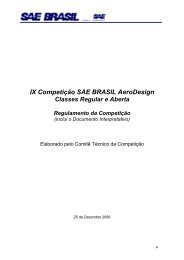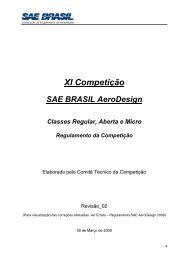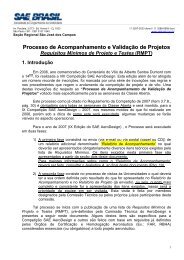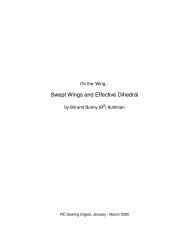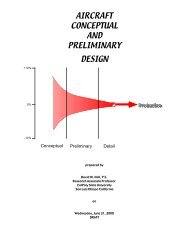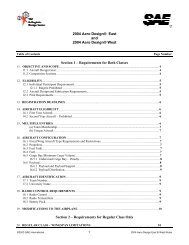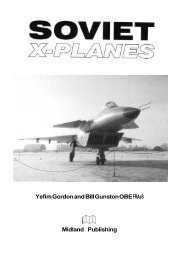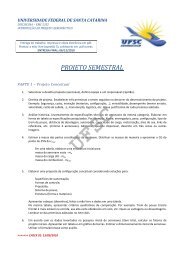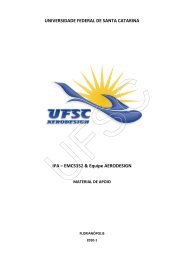Aerodynamic design assessment of Strato 2C ... - UFSC Aerodesign
Aerodynamic design assessment of Strato 2C ... - UFSC Aerodesign
Aerodynamic design assessment of Strato 2C ... - UFSC Aerodesign
Create successful ePaper yourself
Turn your PDF publications into a flip-book with our unique Google optimized e-Paper software.
Aerospace Science and Technology 6 (2002) 43–51<br />
www.elsevier.com/locate/aescte<br />
<strong>Aerodynamic</strong> <strong>design</strong> <strong>assessment</strong> <strong>of</strong> <strong>Strato</strong> <strong>2C</strong> and its potential for<br />
unmanned high altitude airborne platforms<br />
Bewertung der aerodynamischen Auslegung von <strong>Strato</strong> <strong>2C</strong> und dessen<br />
Potential für hochfliegende unbemannte Fluggeräte<br />
Dirk Schawe ∗ , Claas-Hinrik Rohardt, Georg Wichmann<br />
DLR – German Aerospace Center, Institute <strong>of</strong> <strong>Aerodynamic</strong>s and Flow Technology, Lilienthalplatz 7, 38108 Braunschweig, Germany<br />
Received 2 August 2001; revised and accepted 15 October 2001<br />
Abstract<br />
Currently, there is a large interest worldwide in the development <strong>of</strong> High Altitude Long Endurance (HALE) Unmanned Aerial Vehicles<br />
(UAVs) for a number <strong>of</strong> civil and military missions, such as routine weather reconnaissance, surface reconnaissance (forest fires, etc.),<br />
earth observation, border patrol and monitoring, fisheries and wildlife refuge management, chemical and biological agent detection, law<br />
enforcement, disaster assistance and monitoring, telecommunications relay, movie production, agricultural surveying and control, and<br />
provision <strong>of</strong> targeting information. Passenger and transport airplanes operate at cruising altitudes <strong>of</strong> maximum 12 000 m where the density is<br />
about 25% compared to sea level. HALE-UVAs are foreseen to operate in the stratosphere at altitudes <strong>of</strong> 24 000 m, twice as high, where the<br />
density drops to about 3.6% <strong>of</strong> the sea level value influencing the lift <strong>of</strong> the aircraft strongly. The environmental conditions in such altitudes<br />
pose strong requirements for the aerodynamic layout and the power plant <strong>of</strong> an aircraft. In Europe <strong>Strato</strong> <strong>2C</strong> – a manned civil research aircraft<br />
– was until nowadays the only aircraft which reached altitudes above 18 000 m. In this paper <strong>Strato</strong> <strong>2C</strong>’s aerodynamic <strong>design</strong> and propulsion<br />
layout will be presented and critically reviewed for its suitability for these high altitudes. © 2002 Éditions scientifiques et médicales Elsevier<br />
SAS. All rights reserved.<br />
Zusammenfassung<br />
Derzeit gibt es weltweit ein grosses Interesse für die Entwicklung unbemannter Fluggeräte für zivile, als auch militärische Missionen,<br />
die in grossen Höhen und über einen langen Zeitraum operieren sollen (HALE-UAVs – High Altitude Long Endurance Unmanned Aerial<br />
Vehicles). Angedachte Missionen sind Wetterbeobachtung, Umweltüberwachung (Waldbrände, etc.), Erderkundung, Überwachung und<br />
Schutz der Staatsgrenzen, Kontrolle von Fisch- und Tierschutzgebieten, Nachweis chemischer und biologischer St<strong>of</strong>fe in der Atmosphäre,<br />
Strafverfolgung, Katastrophenschutz, Telekommunikation, Filmproduktion, Kontrolle und Überwachung der Landwirtschaft und militärische<br />
Aufklärung und Zielerfassung. Passagier- und Transportflugzeuge operieren in Reiseflughöhen von maximal 12 000 m. In diesen Höhen<br />
hat sich die Luftdichte auf ungefähr 25% des Druckes in Meereshöhe reduziert. Die hochfliegenden unbemannten Fluggeräte sollen in<br />
der <strong>Strato</strong>sphäre bis in Höhen von 24 000 m betrieben werden. Hier sinkt die Luftdichte auf 3.6% des Druckes in Meereshöhe, wodurch<br />
der Auftrieb des Luftfahrzeuges stark beeinflusst wird. Die Umweltbedingungen in solchen Höhen beeinflussen damit sehr stark die<br />
aerodynamische Auslegung des Flugkörpers und die Auswahl und Auslegung des Antriebes. Bis zum heutigen Tag war das zivile bemannte<br />
Forschungsflugzeug <strong>Strato</strong> <strong>2C</strong> in Europa das einzige Fluggerät, das Flughöhen oberhalb 18 000 m erreichte. In diesem Artikel werden die<br />
aerodynamische und antriebsseitige Auslegung von <strong>Strato</strong> <strong>2C</strong> vorgestellt and kritisch auf ihre Eignung für grosse Flughöhen überprüft.<br />
© 2002 Éditions scientifiques et médicales Elsevier SAS. All rights reserved.<br />
Keywords: Airfoil; <strong>Aerodynamic</strong> <strong>design</strong>; Flow separation; UAV<br />
Schlüsselwörter: Tragflügelpr<strong>of</strong>il; Aerodynamischer Entwurf; Strömungsablösung; Drohne<br />
* Correspondence and reprints.<br />
E-mail address: dirk.schawe@dlr.de (D. Schawe).<br />
1270-9638/02/$ – see front matter © 2002 Éditions scientifiques et médicales Elsevier SAS. All rights reserved.<br />
PII: S1270-9638(01)01127-0
44 D. Schawe et al. / Aerospace Science and Technology 6 (2002) 43–51<br />
Nomenclature<br />
A Aspect ratio [–]<br />
cd Airfoil section drag coefficient [–]<br />
CD Drag coefficient [–]<br />
CD0 Zero-lift drag coefficient [–]<br />
cl Airfoil section lift coefficient [–]<br />
CL Lift coefficient [–]<br />
cm0 Pitching moment coefficient [–]<br />
CP Pressure coefficient [–]<br />
d Diameter <strong>of</strong> the propeller [m]<br />
D Drag [N]<br />
e Oswald’s efficiency factor [–]<br />
g Acceleration <strong>of</strong> gravity [9.81 m s−2 ]<br />
H Altitude [m]<br />
L Lift [N]<br />
m Take<strong>of</strong>f weight [kg]<br />
1. Introduction<br />
Condor [4] rang in a new type <strong>of</strong> unmanned aircraft<br />
flying fully autonomous from take<strong>of</strong>f through landing in<br />
high altitudes over long endurances. On 9 October 1988<br />
Boeing’s Condor took <strong>of</strong>f the runway for its first flight.<br />
During seven more successful flights Condor achieved two<br />
Ma Mach number [–]<br />
n Revolutions per minute [1 min −1 ]<br />
p Pressure [Pa]<br />
P Power [W]<br />
r/R Relative propeller radius [–]<br />
Re Reynolds number [–]<br />
S Wing area [m 2 ]<br />
T Thrust [N]<br />
v Velocity [m s −1 ]<br />
x/c Relative chord length [–]<br />
α Angle <strong>of</strong> attack [ ◦ ]<br />
β Geometric blade pitch angle [ ◦ ]<br />
η Propeller efficiency [–]<br />
π 3.1416 [–]<br />
ρ Density [kg m −3 ]<br />
world records, one for an altitude <strong>of</strong> 20 416 m, and one<br />
for an endurance <strong>of</strong> 58 hours 11 minutes. Condor was an<br />
all-bonded composite aircraft with a 60.96 meter wingspan<br />
<strong>of</strong> aspect ratio 36.6 and a lift-to-drag ration (L/D) <strong>of</strong> 40<br />
operating continuously at lift coefficients up to 1.35 with<br />
laminar flow over 50% <strong>of</strong> the upper and lower wing surfaces<br />
at Reynolds numbers <strong>of</strong> 1 million. Condor is powered by two<br />
Fig. 1. History <strong>of</strong> manned and unmanned high altitude and long endurance aircrafts.
130.5 kW turbocharged and liquid cooled six cylinder piston<br />
engines.<br />
Condor’s as well as other aircraft <strong>design</strong>s show that aerodynamics<br />
plays an important role for operating manned or<br />
unmanned aircrafts in high altitudes for extended periods <strong>of</strong><br />
time (Fig. 1). The aerodynamic <strong>design</strong> <strong>of</strong> such a vehicle is<br />
greatly complicated because <strong>of</strong> the dramatic atmospheric implication<br />
at an altitude <strong>of</strong> e.g. 24 000 m (see Table 1). Ambient<br />
density and pressure are just a vanishing fraction <strong>of</strong><br />
their sea level values. The lower speed <strong>of</strong> sound increases local<br />
Mach numbers, and higher kinematic viscosity decreases<br />
Reynolds number. This denotes, that airfoils for HALE-<br />
UAVs operate on fairly high lift coefficients (CL ≈ 1.2−1.5)<br />
at relatively low Reynolds numbers (≈ 1.0 × 10 6 )andrelatively<br />
high Mach numbers (≈ 0.4 − 0.6). For these conditions<br />
we are not able to draw upon already in the past developed<br />
airfoils. Sailplane airfoil data are very near, but are<br />
<strong>design</strong>ed for operating on low Mach numbers (≈ 0.05−0.2).<br />
They might serve as starting geometries for computational<br />
airfoil <strong>design</strong> and optimization procedures ([1,2]).<br />
Another important issue for operating aircraft in the<br />
stratosphere, is the selection <strong>of</strong> the power plant. Turb<strong>of</strong>an<br />
engines are reliable, <strong>of</strong> compact size and therefore easy to<br />
integrate into the aircraft airframe, with high acquisition<br />
costs, low maintenance efforts but moderate operation costs<br />
and high climbing performance. Unfortunately the thrust decreases<br />
proportional with the density, i.e. unmodified turb<strong>of</strong>ans<br />
are limited to about 20 000 m. On the other hand<br />
piston engines with all their accessories (compressors, turbochargers,<br />
heat exchangers, two-stage gear box, propeller,<br />
etc.) have a low but constant performance with increasing<br />
altitude but are much more difficult to integrate. The maximum<br />
altitude for turbocharged and liquid cooled piston engines<br />
is about 26 000 m. The propeller layout for high altitude<br />
operation must provide the aircraft with enough thrust<br />
till density ratios <strong>of</strong> 1: 28.<br />
2. <strong>Strato</strong> <strong>2C</strong> – introduction<br />
<strong>Strato</strong> <strong>2C</strong> is <strong>design</strong>ed as an instrument for ozone and<br />
climate research which was a programme <strong>of</strong> the German<br />
Ministry <strong>of</strong> Education and Technology (BMBF). The project<br />
coordinator was DLR (German Aerospace Center) who was<br />
responsible for the project management, the flight operations<br />
and the scientific instrumentation and mission preparation.<br />
The construction was commissioned 1992 by the German<br />
company Grob.<br />
Its main capabilities have been devoted to:<br />
• research <strong>of</strong> the dynamics and chemistry <strong>of</strong> the atmosphere;<br />
• environmental research (e.g. pollution produced by air<br />
traffic);<br />
• exchange process between troposphere and stratosphere;<br />
D. Schawe et al. / Aerospace Science and Technology 6 (2002) 43–51 45<br />
Table 1<br />
Parameters <strong>of</strong> the International Standard Atmosphere for an altitude <strong>of</strong><br />
24 384 m (80 000 ft)<br />
Variable Value Comp. to S.L.<br />
Altitude 24 384 km (80 000 ft) –<br />
Density 0.04353 kg m−3 3.6%<br />
Pressure 2716.62 Pa 2.7%<br />
Temperature 221.03 K 76.8%<br />
Speed <strong>of</strong> sound 298.04 m s−1 87.6%<br />
Kin. viscosity 3.26 × 10−4 m2 s−1 2 227%<br />
Fig. 2. Dimensions <strong>of</strong> the <strong>Strato</strong> <strong>2C</strong>.<br />
Fig. 3. <strong>Strato</strong> <strong>2C</strong> on its maiden flight on 31 March 1995.<br />
• observation <strong>of</strong> land, ocean and polar icecaps from high<br />
altitude.<br />
The aircraft was <strong>design</strong>ed for altitudes up to 24 000 m<br />
and long endurance and range operations (18 000 km) in the<br />
stratosphere. It was supposed to carry a scientific payload <strong>of</strong><br />
800 to 1 000 kg depending on the flight mission. <strong>Strato</strong> <strong>2C</strong> is<br />
fully built <strong>of</strong> fiber composite materials with a take<strong>of</strong>f weight<br />
<strong>of</strong> about 12 000 kg and a wingspan <strong>of</strong> 56.5 m and a length<br />
and height <strong>of</strong> 23.98 m and 7.76 m, respectively (see Fig. 2).<br />
The first successful flight was on 31 March 1995 (see<br />
Fig. 3). 29 test flights were scheduled successfully until<br />
August 1995. At the last flight <strong>Strato</strong> <strong>2C</strong> reached its<br />
maximum ceiling at 18 500 m.
46 D. Schawe et al. / Aerospace Science and Technology 6 (2002) 43–51<br />
Fig. 4. (a) Altitude <strong>design</strong> mission; and (b) long endurance mission.<br />
3. <strong>Strato</strong>’s missions<br />
The aircraft was <strong>design</strong>ed with regard to two main<br />
mission pr<strong>of</strong>iles. The high altitude mission intended for<br />
stratospheric research has a range <strong>of</strong> 7 000 km with a cruise<br />
endurance <strong>of</strong> 8 hours at an altitude <strong>of</strong> 24 000 m and 800 kg<br />
mission payload (see Fig. 4(a)). The long endurance mission<br />
has a total time <strong>of</strong> 48 hours over a range <strong>of</strong> 18 100 km in<br />
18 000 m ceiling (see Fig. 4(b)).<br />
4. <strong>Aerodynamic</strong>s <strong>of</strong> <strong>Strato</strong> <strong>2C</strong><br />
For <strong>Strato</strong> <strong>2C</strong> an airfoil for operating in high altitudes was<br />
<strong>design</strong>ed without disregarding the requirements for start,<br />
climb, descent and landing. The <strong>design</strong> Reynolds number<br />
<strong>of</strong> 1.0 × 10 6 combined with a fairly high lift coefficient at<br />
relatively high Mach number <strong>of</strong> Ma = 0.43 causes normally<br />
laminar separation bubbles with turbulent reattachments on<br />
smooth surfaces which produce additional pressure drag.<br />
These unusual <strong>design</strong> criteria yield to a laminar airfoil –<br />
named LH37 [7] – <strong>of</strong> 17.5% maximum thickness located<br />
at x/c = 0.354 and a maximum camber <strong>of</strong> 0.040 located at<br />
x/c = 0.385. The pitching moment is cm0 =−0.13, and for<br />
lift coefficients between 0.3 and 1.5 low drag is achieved.<br />
The relatively high airfoil thickness affects the structural<br />
weight positively and enlarges the torsional stiffness <strong>of</strong> the<br />
high aspect ratio wing.<br />
The main goal <strong>of</strong> the airfoil <strong>design</strong> was to achieve high<br />
lift coefficients while the drag remains rather low. High lift<br />
occurs from high pressure differences between the upper<br />
and lower surface <strong>of</strong> the airfoil, i.e. the upper surface<br />
<strong>of</strong> the airfoil features high suction and the lower surface<br />
overpressure over the whole chordlength. A low friction drag<br />
will be reached by large laminar extends even at high lift<br />
coefficients. The drawback <strong>of</strong> such a <strong>design</strong> goal is that<br />
the airfoil will respond very sensitively on a poor finish<br />
qualtiy and/or slightest contamination <strong>of</strong> the wing. This<br />
effect is demonstrated in Fig. 5. The subsonic wind-tunnel<br />
MUB located at the DLR in Braunschweig (Germany) was<br />
equipped with a smooth and clean LH37-wing <strong>of</strong> constant<br />
Fig. 5. Experimentally determined lift coefficient versus angle <strong>of</strong> attack for<br />
Ma = 0.39 and Re = 1.1 × 10 6 .<br />
chordlength in order to realize quasi-2D conditions. The<br />
upper curve shows the lift coefficient distribution versus<br />
the angle <strong>of</strong> attack for the unchanged wing. In a second<br />
experiment the point <strong>of</strong> transition was set to 7% <strong>of</strong> the<br />
chordlength on the upper and lower surface in order to<br />
simulate a poor quality and/or contaminated wing. The result<br />
was a significantly reduced performance <strong>of</strong> the airfoil caused<br />
by fully turbulent flow and additionally by the beginning <strong>of</strong> a<br />
trailing edge separation for angles <strong>of</strong> attack <strong>of</strong> α = 7.5 ◦ and<br />
higher. The maximum difference gained by laminar flow in<br />
units <strong>of</strong> the lift coefficient is 0.4 at an angles <strong>of</strong> attack <strong>of</strong><br />
α = 10 ◦ . The airfoil is non-critical because for increasing<br />
angles <strong>of</strong> attack the lift does not breakdown.<br />
The performance <strong>of</strong> the airfoil was calculated with the<br />
two-dimensional viscous aerodynamic <strong>design</strong> and analysis<br />
code ISES <strong>of</strong> Drela/Giles [1] and experimentally verified in<br />
the subsonic wind-tunnel MUB. For a Mach number <strong>of</strong> 0.3,<br />
cl = 1.5 and 7.5 ◦ angle <strong>of</strong> attack we received a very good<br />
conformity in the cp-distribution <strong>of</strong> computer simulation and<br />
experimental measurement. In this case transition through a<br />
laminar separation bubble occurred on the upper surface <strong>of</strong><br />
the airfoil at x/c = 0.38 and on the lower surface at x/c =<br />
0.79 (see Fig. 6). Keeping laminar flow on the airfoil’s upper<br />
surface till 38% chordlength at such high cl’s is a reasonable<br />
value. If the lift coefficient will be reduced to cl = 1.25 the<br />
laminar extend could be held up till 45% chordlength.<br />
Airfoils where the flow remains laminar over a wide<br />
chordlength at high lift coefficients produce low drag over<br />
a wide cl-range as shown in Fig. 7. The drag increase<br />
<strong>of</strong> the airfoil LH37 received from wind-tunnel experiment<br />
compared with a computer simulation for Ma = 0.39 and
Re = 1.2 × 10 6 is pretty small until cl = 1.5. For higher<br />
lift coefficients the drag increases significantly but without<br />
cl-breakdown, which indicates too that the stall behaviour<br />
<strong>of</strong> the airfoil is noncritical. The shapes <strong>of</strong> both polars are<br />
very similar although the simulated one achieved lower drag.<br />
The lower drag values <strong>of</strong> the simulated one is caused by the<br />
restricted mathematical description <strong>of</strong> the flow physics on<br />
which the computer program is based.<br />
Fig. 6. Theoretically and experimentally determined pressure distribution<br />
for Ma = 0.3, cl = 1.5, Re = 1.0 × 10 6 and α = 7.5 ◦ .<br />
Fig. 7. Drag polar for the airfoil LH37 for Ma = 0.39 and Re = 1.2 × 10 6 .<br />
D. Schawe et al. / Aerospace Science and Technology 6 (2002) 43–51 47<br />
<strong>Strato</strong> <strong>2C</strong> has a slight dihedral (1 ◦ ) triple swept wing with<br />
a straight trailing edge and is equipped with an aileron and a<br />
conventional Schempp–Hirth flap.<br />
For the empennage symmetric laminar flow Eppler airfoils<br />
were selected.<br />
4.1. Wing-engine nacelle interference<br />
The engine-nacelle is bluntly mounted on top <strong>of</strong> the wing<br />
without fillets/fairings. In such regions flow separations<br />
occur because <strong>of</strong> an appearing cross-flow caused by the<br />
pressure differences between the flow around the nacelle<br />
and the suction side <strong>of</strong> the airfoil. Due to the pressure<br />
gradients a cross-flow from nacelle to wing is caused. The<br />
boundary layer <strong>of</strong> the wing in the near region <strong>of</strong> the nacelle<br />
will be thickened and therefore susceptible to separation,<br />
especially when the wing operates at high lift coefficients.<br />
Furthermore a vortex developes in the intersection <strong>of</strong> the<br />
wing and nacelle. The separation area is wedge shaped,<br />
running on the upper surface <strong>of</strong> the wing from the pressure<br />
minimum under an angle <strong>of</strong> 45 ◦ spanwise to the trailing edge<br />
(see Fig. 8).<br />
Several methods could possibly weaken or dampen the<br />
affinity <strong>of</strong> separation. Most methods provoke increasing<br />
the energy in the boundary layer against positive pressure<br />
gradients:<br />
• cowling the wing-nacelle intersection with fairings which<br />
will reduce the pressure gradient after the maximum airfoil<br />
thickness;<br />
• modifying the power plant integration by positioning<br />
the nacelle with the engine inlet on the underwing<br />
(see Fig. 9(a)), where the pressure gradients are much<br />
lower, and therefore the boundary layer responds less<br />
sensitive on disturbances. An additional advantage is<br />
the possibility <strong>of</strong> integrating the landing gear into the<br />
nacelle (see Fig. 9(b)), and thereby avoiding the vortex<br />
generating belly fairing;<br />
Fig. 8. Flow separation area in the wing-nacelle intersection.
48 D. Schawe et al. / Aerospace Science and Technology 6 (2002) 43–51<br />
(a)<br />
(b)<br />
Fig. 9. (a) Modified power plant integration; (b) integration <strong>of</strong> the landing<br />
gear into the nacelle (proposed by IABG).<br />
• feeding the decelerated fluid particles <strong>of</strong> the boundary<br />
layer with additional energy by blowing air into flow<br />
direction. The flow velocity will increase and thereby<br />
the separation risk reduced;<br />
• the boundary-layer suction could be performed in the<br />
area <strong>of</strong> increasing pressure, where the retarded flow will<br />
be sucked <strong>of</strong>f, and the non-retarded flow layers will<br />
build the new boundary layer which is more resistent<br />
against flow separation;<br />
• influencing the boundary layer with vortex generators<br />
in order to exchange high-energy fluid particles <strong>of</strong> the<br />
outside flow with the boundary layer.<br />
Three <strong>of</strong> these five methods – fairings, vortex generators<br />
and blowing out – for avoiding flow separation in the wingnacelle<br />
intersection were investigated in the subsonic windtunnel<br />
MUB on a model with scale 1: 22.4.<br />
The surveyed vortex generators could not prevent the flow<br />
from separation. A more successful and less expensive approach<br />
was the modification <strong>of</strong> the wing-nacelle intersection<br />
with different fairings. These experiments made obvious<br />
that an important parameter for avoiding separations completely<br />
is to lengthen the fairing behind the wing trailing<br />
edge. The fairing shown in Fig. 10 eliminated the separation<br />
completely. Another promising solution was blowing air into<br />
the boundary layer at x/c = 0.4 with a velocity <strong>of</strong> 80 m s −1<br />
(�p = 1.5 × 10 5 Pa). For this configuration the separation<br />
Fig. 10. Modified wing-nacelle intersection with an optimized fairing.<br />
vanished completely. For the real aircraft the exhaust gases<br />
<strong>of</strong> the engine could be blown into the wing-nacelle intersection<br />
with a volume flow rate <strong>of</strong> 30 ls −1 .<br />
A more detailed investigation about the wing-nacelle interferences<br />
including wind-tunnel experiments and methods<br />
to reduce their drag contribution are given in [5].<br />
5. Performance evaluation <strong>of</strong> <strong>Strato</strong> <strong>2C</strong>’s propeller<br />
The propulsion system (see Fig. 11) is a combination <strong>of</strong> a<br />
300 kW piston engine with a gas generator which serves as<br />
a turbocharger and provides an additional jet thrust <strong>of</strong> about<br />
12% <strong>of</strong> the propeller thrust at <strong>design</strong> altitude (24 000 m).<br />
Between each compressor stage the air is cooled by intercoolers.<br />
The compressor has an overall compression ratio <strong>of</strong><br />
32 : 1 and provides charge air for the engine’s manifold inlet<br />
at 24 000 m <strong>of</strong> sea level condition.<br />
Each <strong>of</strong> the two engines mounted in large nacelles on<br />
top <strong>of</strong> the wing drives a wooden Kevlar composite coated<br />
variable-pitch five-blade, constant speed and six meter<br />
diameter propeller, working in pusher mode. The propeller<br />
is abnormally strongly twisted from β = 43 ◦ at the propeller<br />
hub to −10 ◦ at the tip.<br />
Fig. 11. Propulsion system <strong>of</strong> <strong>Strato</strong> <strong>2C</strong>.
Fig. 12. Strongly twisted propeller <strong>of</strong> <strong>Strato</strong> <strong>2C</strong>. The four airfoil sections<br />
are taken into account for the evaluation.<br />
Fig. 13. Reynolds number distribution <strong>of</strong> one propeller blade at four<br />
altitudes.<br />
The propeller was <strong>design</strong>ed for operating in the stratosphere<br />
from 12 000 m up to the maximum mission altitude<br />
<strong>of</strong> 24 000 m. In other words, the propeller must cover a remarkable<br />
Reynolds number range from 1.8 × 10 5 to far beyond<br />
1.0 × 10 6 (see Fig. 13). For the performance evaluation<br />
four discrete flight levels 12 000 m, 18 500 m, 22 000 m<br />
and 24 000 m have been selected. Therefore one propeller<br />
blade was discretized into four airfoil sections (see Fig. 12).<br />
The pressure distributions and the drag polars for these four<br />
airfoils were calculated with the two-dimensional viscous<br />
aerodynamic <strong>design</strong> and analysis code ISES <strong>of</strong> Drela and<br />
Giles [1] and published in [6]. The problem <strong>of</strong> calculating<br />
the drag polars <strong>of</strong> various propeller slices are the very low<br />
Reynolds numbers below 200 000 at relatively high Mach<br />
numbers between 0.6 and 0.8. Up to now ISES still <strong>of</strong>fers<br />
the highest accuracy for such flow conditions. But its error<br />
should not be underestimated, and 20% to 30% error should<br />
be taken into account. The performance characteristics <strong>of</strong> the<br />
propeller are calculated on the basis <strong>of</strong> the afore determined<br />
aerodynamic characteristics with a computer program developed<br />
by Hepperle [3]. This computer code is based on the<br />
combined blade-element and momentum theory which accounts<br />
for details <strong>of</strong> the propeller airfoil geometry and their<br />
D. Schawe et al. / Aerospace Science and Technology 6 (2002) 43–51 49<br />
aerodynamic forces in order to <strong>design</strong> and analyse an optimal<br />
propeller for the selected application.<br />
The main <strong>assessment</strong> criterion for propellers is whether<br />
they are capable <strong>of</strong> providing the airplane with sufficient<br />
thrust for level flight at these operation altitudes, and<br />
furthermore if they have an adequate climbing performance<br />
reserve in order to reach the maximum altitude in a finite<br />
period <strong>of</strong> time. The basis for calculating the propeller<br />
performance are the drag polars in various slices, especially<br />
between 60% and 90% <strong>of</strong> the propeller radius where the<br />
main thrust is produced. In Fig. 14 we observe that for<br />
altitudes above operation altitude 2 (18 500 m, see also<br />
Table 2) the drag for the 60% slice experienced a strong<br />
increase, which indicates flow separation. In the 80% slice<br />
the flow is still attached, but separates nearby operation<br />
altitude III (22 000 m). These observations indicate that<br />
the propeller is limited to altitudes between 18 500 m and<br />
22 000 m. This presumption will be confirmed if we look at<br />
the thrust <strong>of</strong> the propeller, the maximum power <strong>of</strong> the engine,<br />
and the drag produced by the aircraft.<br />
This minimal thrust necessary for level flight is approximately<br />
equal to the drag D <strong>of</strong> the airplane flying at velocity<br />
v:<br />
D = ρ<br />
2 v2SCD, with CD = CD0 + C2 L<br />
, (1)<br />
πAe<br />
where S = 150 m2 .<br />
CL is calculated using<br />
CL = mg<br />
ρ<br />
2 v2S with m = 12 000 kg.<br />
e is the Oswald’s efficiency factor which depends<br />
only on the Mach number. A value <strong>of</strong> e = 1 indicates<br />
an elliptical lift distribution. For the calculations e =<br />
0.865 = const, A = 21.28.<br />
However, in the incompressible theory for positive propeller<br />
thrust TP it will be assumed that the flow through the<br />
propeller disk is incompressible and irrotational. From this<br />
theory we are able to calculate the perfect/ideal propeller efficiency<br />
ηid as follows:<br />
�<br />
2P<br />
v = ηid<br />
πρd2 �1/3 , (2)<br />
(1 − ηid)<br />
with P the power output and d the diameter <strong>of</strong> the propeller.<br />
Here, the thrust <strong>of</strong> a perfectly working propeller is<br />
Tid = ηidP<br />
. (3)<br />
v<br />
If we pursue the propeller thrust and the aircraft drag (remark:<br />
propeller thrust given for one engine and aircraft drag<br />
refers only to the half aircraft. The additional jet thrust <strong>of</strong><br />
about 12% <strong>of</strong> the gas generator is not considered.) for maintaining<br />
level flight with increasing altitude in Fig. 15 and
50 D. Schawe et al. / Aerospace Science and Technology 6 (2002) 43–51<br />
Fig. 14. Drag polar <strong>of</strong> the propeller airfoil section at 60% and 80% radius. The roman numbers (I, II, III, IV) indicate the four operation altitudes which are<br />
specified in Table 2.<br />
Table 2<br />
Physical properties for four discrete operation altitudes. Comparison <strong>of</strong> the aircraft drag in level flight with the thrust provided<br />
by the propeller. (Remark: Drag, Thrust and Power are referred to one engine without considering the 12% additional thrust <strong>of</strong><br />
the gas generator.)<br />
Operation altitude I II III IV<br />
Altitude H [m] 12 000 18 500 22 000 24 000<br />
Density ρ [kg m−3 ] 0.30 0.11 0.064 0.047<br />
Flight velocity v [m s−1 ] 62.2 101.3 131.3 153.8<br />
Mach number Ma [–] 0.21 0.34 0.45 0.52<br />
Lift coefficient CL [–] 1.35 1.37 1.42 1.41<br />
Zero–lift drag coefficient CD [–] 0 0.023 0.025 0.026 0.027<br />
Drag coefficient CD [–]<br />
Twist angle β75 [<br />
0.054 0.057 0.061 0.062<br />
◦ ]<br />
Advance ratio<br />
26.0 43.5 48.5 64.0<br />
v/nd[–] 1.088 1.772 2.066 2.418<br />
RPM n [ 1/min] 572 572 636 636<br />
Power output P [kW] 179 298 300 300<br />
Efficiency η [–] 0.87 0.87 0.84 0.64<br />
Perfect efficiency ηid 0.96 0.96 0.97 0.97<br />
η/ηid 0.91 0.91 0.87 0.66<br />
Comparison aircraft drag in level flight D with propeller thrust TP<br />
D [N] 2 376.9 2 468.1 2 524.3 2 563.3<br />
TP [N] 2 502 2 556 1 909 1 252<br />
Fig. 15. Propeller thrust and aircraft drag versus altitude. (Remark: both<br />
forces refer to one Propeller or in lieu <strong>of</strong> the drag, <strong>of</strong> the half aircraft.)<br />
Table 2 we observe that for 18 500 m level flight with only a<br />
very modest climbing capability could be ensured. However,<br />
above 19 000 m the drag exceeds the propeller thrust. For<br />
further climbing to higher altitudes additional power equal<br />
the aircraft weight multiplied with the sine <strong>of</strong> the flight-path<br />
angle (= climbing velocity/flight velocity) is necessary. The<br />
engine however, already operates, at 18 500 m, at its power<br />
limit <strong>of</strong> 300 kW. The relative efficiency <strong>of</strong> the propeller<br />
η/ηid which indicates the performance rate <strong>of</strong> a perfectly<br />
working propeller, drops rapidly from 91% in 18 500 m to<br />
66% in 24 000 m.<br />
6. Conclusion<br />
Airborne platforms for altitudes above 20 000 m are until<br />
nowadays a challenge for the aerodynamic <strong>design</strong>. Each<br />
meter altitude for a given payload is hard-won through<br />
optimizing each detail <strong>of</strong> the aircraft. This is aggravated<br />
by the fact that these details are interdependent. The main<br />
<strong>design</strong> challenges are:
• a laminar wing, producing drag as low as possible at<br />
high lift coefficients;<br />
• a drag minimized fuselage;<br />
• a flow optimized wing-fuselage intersection with only<br />
low pressure gradients in order to avoid flow separation;<br />
• the selection <strong>of</strong> a suitable power plant, and its integration<br />
into the airframe without interfering the flow too<br />
much; and<br />
• if the power plant is a piston engine the propeller should<br />
be adjusted optimally to the shaft power <strong>of</strong> the engine<br />
and the altitude range to be covered.<br />
The research aircraft <strong>Strato</strong> <strong>2C</strong> accomplished these requirements<br />
for its <strong>design</strong> altitude <strong>of</strong> 24 000 m only with regard<br />
to the wing <strong>design</strong> based on the airfoil LH37 and the<br />
selection <strong>of</strong> a turbocharged piston engine as power plant.<br />
The other points need improvement. The specific problems<br />
in summary were:<br />
• the belly fairing for the landing gear at the fuselage<br />
generates high drag vortical flow;<br />
• the wing was mounted in high wing configuration<br />
without suitable fairings;<br />
• the large nacelles are just put on the wing with sharp<br />
intersections. No additional devices influencing the flow<br />
in the intersection are envisioned. Large flow separation<br />
areas were the result;<br />
• the propeller together with the 300 kW piston engine<br />
is not capable to bring <strong>Strato</strong> <strong>2C</strong> in its current layout<br />
into altitudes <strong>of</strong> 24 000 m. With reasonable climbing<br />
D. Schawe et al. / Aerospace Science and Technology 6 (2002) 43–51 51<br />
velocities 18 500 m was reached. Further climbing is<br />
possible but not practical because <strong>of</strong> the vanishing<br />
climbing rate.<br />
The preliminary layout <strong>of</strong> such aircrafts is still afflicted<br />
with errors which should not be underestimated. The reasons<br />
are the lack <strong>of</strong> suitable and accurate tools on the theoretical<br />
side (CFD codes) as well on the practical side (windtunnels)<br />
to determine the aerodynamics <strong>of</strong> a body flying at<br />
low Reynolds numbers with high lift coefficients and high<br />
Mach numbers. Nevertheless the available tools point out the<br />
trends with 20–30% accuracy.<br />
References<br />
[1] M. Drela, M.B. Giles, ISES: A two-dimensional viscous aerodynamic<br />
<strong>design</strong> and analysis code, AIAA paper 87-0424, 1987.<br />
[2] R. Eppler, D. Somers, A Computer Program for the Design and<br />
Analysis <strong>of</strong> Low-Speed Airfoils, NASA-TM-80210, 1980.<br />
[3] M. Hepperle, Ein Computerprogramm für den Entwurf und Analyse<br />
von Propellern, Institut für Flugzeugbau der Universität Stuttgart, 1984.<br />
[4] R. Johnstone, N. Arntz, CONDOR – High altitude long endurance<br />
(HALE) automatically piloted vehicle (APV), AIAA paper 90-3279,<br />
1990.<br />
[5] Ph. Tölke, A. Quast, Untersuchungen zur Ablösung im Bereich<br />
der Flügel-Gondel-Verschneidung am Forschungsflugzeug <strong>Strato</strong> <strong>2C</strong>,<br />
DLR-IB 129-96/36, 1996.<br />
[6] G. Wichmann, H. Köster, Leistungsnachrechnung des Propellers des<br />
Höhenforschungsflugzeugs <strong>Strato</strong> <strong>2C</strong>, DLR-IB 129-96/31, 1996.<br />
[7] G. Wichmann, C.H. Rohardt, P. Hirt, Kenndaten für Pr<strong>of</strong>ile: Pr<strong>of</strong>il DLR-<br />
LH37, Luftfahrttechnisches Handbuch – LTH, Band Aerodynamik AD<br />
41102-24, 1998.



